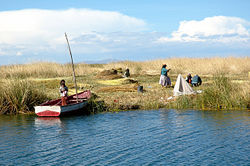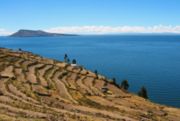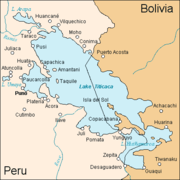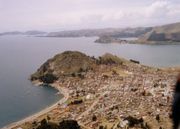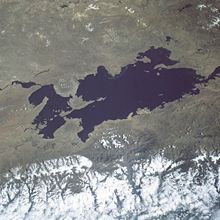Lake Titicaca
2008/9 Schools Wikipedia Selection. Related subjects: Central & South American Geography
| Titicaca | |
|---|---|
|
|
|
| Coordinates | |
| Lake type | Mountain Lake |
| Primary inflows | 27 rivers |
| Primary outflows | Desaguadero River Evaporation |
| Catchment area | 58,000 km² (22,400 sq mi) |
| Basin countries | Peru Bolivia |
| Max. length | 190 km (118 mi) |
| Max. width | 80 km (50 mi) |
| Surface area | 8,372 km² (3,232 sq mi) |
| Average depth | 107 m (351 ft) |
| Max. depth | 284 m (932 ft) |
| Water volume | 893 km³ (214 cu mi) |
| Shore length1 | 1,125 km (699 mi) |
| Surface elevation | 3,812 m (12,507 ft) |
| Islands | 42+ islands See Article |
| Settlements | Puno, Peru Copacabana, Bolivia |
| 1 Shore length is not a well-defined measure. | |
Lake Titicaca is a lake located on the border of Bolivia and Peru. It sits 3,812 m (12,507 ft) above sea level making it the highest commercially navigable lake in the world. By volume of water it is also the largest lake in South America.
Overview
The lake is located at the northern end of the endorheic Altiplano basin high in the Andes on the border of Peru and Bolivia. The western part of the lake lies within the Puno Region of Peru, and the eastern side is located in the Bolivian La Paz Department.
The lake is composed of two nearly separate sub-basins that are connected by the Strait of Tiquina which is 800 m (2,620 ft) across at the narrowest point. The larger sub-basin, Lago Grande (also called Lago Chucuito) has a mean depth of 135 m (443 ft) and a maximum depth of 284 m (932 ft). The smaller sub-basin, Lago Huiñaimarca (also called Lago Pequeño) has a mean depth of 9 m (30 ft) and a maximum depth of 40 m (131 ft). The overall average depth of the lake is 107 m (351 ft).
Lake Titicaca is fed by rainfall and meltwater from glaciers on the sierras that abut the Altiplano. Five major river systems feed into Lake Titicaca—in order of their relative flow volumes these are: Ramis, Coata, Ilave, Huancané, and Suchez. More than 20 other smaller rivers empty into Titicaca, and the lake has 41 islands, some of which are densely populated.
Having only a single season of free circulation, the lake is monomictic and water passes through Lago Huiñaimarca and flows out the single outlet at the Rio Desaguadero, which then flows south through Bolivia to Lake Poopó. This only accounts for about 10% of the lake's water balance. Evapotranspiration, caused by strong winds and intense sunlight at altitude, balances the remaining 90% of the water input. It is nearly a closed lake.
Islands
Uros
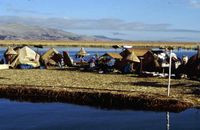
Titicaca is notable for a population of people who live on the Uros, a group of 42 or so artificial islands made of floating reeds ( totora, a reed that abounds in the shallows of the lake). These islands have become a major tourist attraction for Peru, drawing excursions from the lakeside city of Puno. Their original purpose was defensive, and they could be moved if a threat arose. Many of the islands contain watchtowers largely constructed of reeds.
Amantaní
Amantaní is another small island on Lake Titicaca populated by Quechua speakers. About 800 families live in six villages on the roughly circular 15 square kilometres (6 sq mi) island. There are two mountain peaks, called Pachatata (Father Earth) and Pachamama (Mother Earth), and ancient ruins on the top of both peaks. The hillsides that rise up from the lake are terraced and planted with wheat, potatoes, and vegetables. Most of the small fields are worked by hand. Long stone fences divide the fields, and cattle, sheep, and alpacas graze on the hillsides.
There are no cars on the island, and no hotels. A few small stores sell basic goods, and there is a health clinic and school. Electricity was produced by a generator and provided limited to a couple of hours each day, but with the rising price of the petroleum, they no longer use the generator. Most families use candles or flash lights powered by batteries or hand-cranks.
Some of the families on Amantaní open their homes to tourists for overnight stays and provide cooked meals, arranged through tour guides. The families who do so are required to have a special room set aside for the tourists and must fit a code by the tour companies that help them. Guests typically take food staples (cooking oil, rice, sugar) as a gift or school supplies for the children on the island. They hold nightly traditional dance shows for the tourists where they offer to dress them up in their traditional clothes and participate.
Taquile
Taquile is a hilly island located 35 kilometres east of Puno. It's narrow and long, and was used as a prison during the Spanish Colony and well into the beginning of the 20th century. In 1970 it became property of the Taquile people, who inhabit the island since then (current population around 3,000). Taquiles have maintained their traditions and culture pretty much unchanged for centuries, and are renowned in the area for their high-quality, colourful textiles. Pre- Inca ruins are found on the highest part of the island, and agricultural terraces on hillsides. The main town in the island, also called Taquile, counts a textile cooperative shop, some small restaurants, and available rooms in family houses where visitors can stay for the night.
Isla del Sol
Situated on the Bolivian side of the lake with regular boat links to the Bolivian town of Copacabana, Isla del Sol ("Island of the sun") is one of the lake's largest islands.
The chronicler Bernabé Cobo documented two versions of an Inca origin myth that took place on the northern part of this island. The first Inca Manco Capac is said to have emerged from a prominent crag in a large sandstone outcrop known as Titikala (the Sacred Rock). Manco Capac is the son of Inti the Andean deity identified as the sun. In one version of the myth, the ancient people of the province were without light in the sky for many days and grew frightened of the darkness. Finally, the people saw the Sun emerge from the crag and believed it was the Sun's dwelling place. In another version related by Cobo, others believed the crag was dedicated to the Sun because it hid under the crag during a great Flood. Isla del Sol was the first land that appeared after the flood waters began to recede and the Sun emerged from Titikala to illuminate the sky once again. A temple was built at this rock and later expanded by the 10th Inca Tupac Inca Yupanqui. He built a covenant for mamaconas (chosen women) and a tambo (inn) for visiting pilgrims.
Excavations at the archaeological site of Ch'uxuqullu, located on a small peak above the Bay of Challa, led to the recovery of Archaic Preceramic remains that radiocarbon dated to about 2200 cal BC. Eight obsidian flakes were recovered from this context, and Neutron Activation Analysis of three of the flakes revealed that all of them were from the Chivay obsidian source which is located in the Colca Canyon, Department of Arequipa. The presence of Chivay obsidian is clear evidence that inhabitants of the island were participating in a wider network of exchange.
According to one bathymetric model, there is no path between the shore edge and the Island of the Sun that does not pass over areas where the lake bottom reaches a depth of 200 m (660 ft) or greater. Paleoclimate studies indicate that around 3100 BC the level of Lake Titicaca would have been as much as 85 m (279 ft) lower than modern conditions, but that it had reached near modern levels by about 2000 BC. Thus, at 2200 BC lake levels were probably lower than at present. Data from Ch'uxuqullu could suggest that lake shore cultures were using well-developed watercraft technology during the Archaic period.
Underwater archaeological investigations conducted off the Island of the Sun from 1989-92 led to the discovery of both Inca and Tiahuanaco artifacts. These are now on display at a site museum in Challapampa.. Today the economy of the island is mainly driven by tourism revenues, but subsistence agriculture and fishing are widely practiced.
Suriqui
Suriqui lies in the Bolivian part of lake Titicaca (in the south-eastern part also known as lake Huiñamarca).
Suriqui is thought to be the last place where the art of reed boat construction survives, at least as late as in 1998. Craftsmen from Suriqui helped Thor Heyerdahl in the construction of several of his projects, such as the reed boats Ra II and Tigris, and a balloon gondola.
Name
The origin of the name Titicaca is unknown. It has been translated as "Rock Puma", allegedly because of its resemblance to the shape of a puma hunting a rabbit, combining words from the local languages Quechua and Aymara, and as well as translated as "Crag of Lead." Locally, the lake goes by several names. Because the southeast quarter of the lake is separate from the main body (connected only by the Strait of Tiquina), the Bolivians call it Lago Huiñaymarca ( Quechua: Wiñay Marka) and the larger part Lago Chucuito. In Peru, these smaller and larger parts are referred to as Lago Pequeño and Lago Grande, respectively.
Transport
A ferry connects the 1435mm gauge railway of Peru at Puno with the 1000mm gauge railway of Bolivia at Guaqui.

